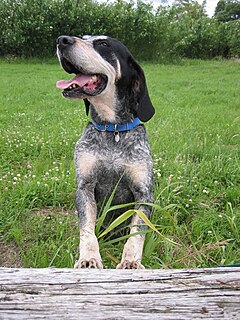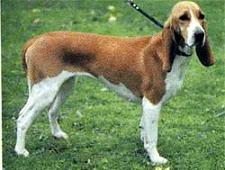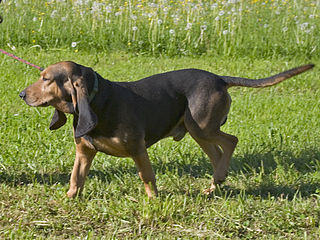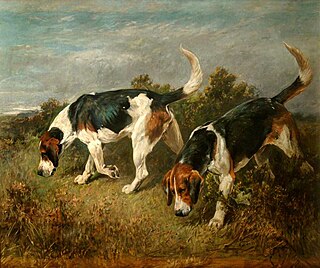Related Research Articles

The Basset Hound is a short-legged breed of dog in the hound family. The Basset is a scent hound that was originally bred for the purpose of hunting hare. Their sense of smell and ability to ground-scent is second only to the Bloodhound.

Scent hounds are a type of hound that primarily hunts by scent rather than sight. These breeds are hunting dogs and are generally regarded as having some of the most sensitive noses among dogs. Scent hounds specialize in following scent or smells. Most of them tend to have long, drooping ears and large nasal cavities to enhance smell sensitivity. They relatively need to have high endurance to be able to keep track of scent over long distances and rough terrain. It is believed that they were originally bred by the Celts.

The Grand Bleu de Gascogne is a breed of hounds of the scenthound type, originating in France and used for hunting in packs. Today's breed is the descendant of a very old type of large hunting dog, and is an important breed in the ancestry of many other hounds.

The Billy is a large scenthound originating from central western France.

The Gończy Polski, sometimes translated as the Polish Hound or the Polish Hunting Dog, is a breed of scent hound originating in Poland.

The Kerry Beagle is the only extant scent hound breed native to Ireland.

The Porcelaine[pɔʁsəlɛn] is a breed of dog originating from France. In 1844, this scent hound was originally called “Briquets Francs Comtois” and named after a French region bordering Switzerland.

The Schweizer Laufhund is a breed of scenthound, originally from Switzerland.

The Bruno Jura Hound is a breed of scenthound from the Jura Mountains on the French-Swiss border.

The Transylvanian Hound is a dog breed originating from Hungary and Transylvania and was historically primarily used for hunting. It is a strong, medium-sized scent hound, characterized by a black body, with tan and sometimes white markings on the muzzle, chest and extremities, and distinctive tan eyebrow spots. It has a high-pitched bark for a dog of its size. The breed was rescued from extinction by focused breeding efforts in the late 20th century. There were formerly two varieties, the tall and the short, developed for different kinds of hunting in the Middle Ages. Only the tall variety survives today.

The Taigan, and also known as Kyrgyz Taighany, is a breed of sighthound from Kyrgyzstan. The Taigan is found in the alpine Tian Shan region of Kyrgyzstan on the border with China, it is closely related to the Tazy and the Afghan hound.

Dog types are broad categories of domestic dogs based on form, function, or style of work, lineage, or appearance. Some may be locally adapted dog types that may have the visual characteristics of a modern purebred dog. In contrast, modern dog breeds strictly adhere to long-established breed standards, that began with documented foundation breeding stock sharing a common set of inheritable characteristics, developed by long-established, reputable kennel clubs that recognize the dog as a purebred.

The Schweizerischer Niederlaufhund, is a breed of dog of the scenthound type from Switzerland. Niederlaufhund means short-legged hound. The breed has a number of different varieties.

The bloodhound is a large scent hound, originally bred for hunting deer, wild boar and, since the Middle Ages, for tracking people. Believed to be descended from hounds once kept at the Abbey of Saint-Hubert, Belgium, in French it is called, le chien de Saint-Hubert.

The Buckhound was a breed of now extinct scent hound from England; they were used to hunt fallow deer in packs.

The Staghound, sometimes referred to as the English Staghound, is an extinct breed of scent hound from England. A pack hound, the breed was used to hunt red deer and became extinct in the 19th century when the last pack was sold.

The West Country Harrier, sometimes called Somerset Harrier, is a breed of scent hound from the south west of England that is used to hunt hare in packs. The West Country Harrier is often considered to be a variety of the more common Harrier breed, which is sometimes referred to as the Studbook Harrier.

The King's White Hound, the Chien Blanc du Roi in French, was a now extinct breed of scent hound from France. The breed was said to be the favourite of the French kings from Louis XI to Louis XIV.

Bassets are a sub-type of scenthound deliberately bred with short legs, that are used for hunting where the hunters accompany the hunting hounds on foot.
References
- 1 2 Alderton, David (2000). Hounds of the World. Shrewsbury: Swan Hill Press. p. 112. ISBN 1-85310-912-6.
- 1 2 3 4 Fogle, Bruce (2009). The Encyclopedia of the Dog. New York: DK Publishing. p. 191. ISBN 978-0-7566-6004-8.
- ↑ Hancock, David (2014). Hounds: Hunting by Scent. Ramsbury, Marlborough: The Crowood Press. p. 169. ISBN 978-1-84797-601-7.
